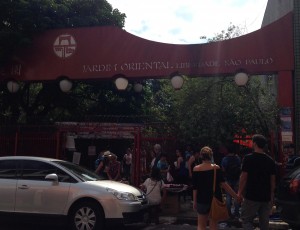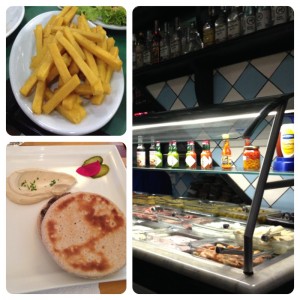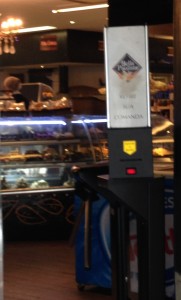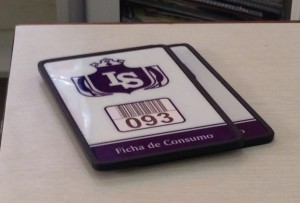Somehow Bruna and Maisa have a sixth sense for knowing when I’m feeling lonely or sad. A few weeks ago, when I was having a particularly difficult weekend, Bruna messaged me Sunday morning, asking me if I wanted to take a walk down Paulista and grab lunch with her and Caio. Of course I jumped at the offer both to spend time with this sweet couple and to also force myself to get out of the house.
Upon my request, we headed to “Shopping 3,” where it appeared that half the city of Sao  Paulo had flocked to look over the temporary stands that are set up every Sunday. Caio confirmed my estimate, explaining that, in the absence of a coast, Sao Paulo’s 40+ “shoppings” are the city’s answer to a weekend beach trip (Maisa had abandoned us for the real beach that weekend). Thus we spent a happy hour, meandering through the stands, Caio and Bruna helping me carefully pick out souvenirs. Upon leaving the shopping mall, Caio suggested that we wander around Liberdade, the city’s “Little Japan.” While I am not partial to sushi (way too ditzy for a gordinha like me), I was excited to see this famous neighborhood, which houses the largest population of Japanese people outside of Japan.
Paulo had flocked to look over the temporary stands that are set up every Sunday. Caio confirmed my estimate, explaining that, in the absence of a coast, Sao Paulo’s 40+ “shoppings” are the city’s answer to a weekend beach trip (Maisa had abandoned us for the real beach that weekend). Thus we spent a happy hour, meandering through the stands, Caio and Bruna helping me carefully pick out souvenirs. Upon leaving the shopping mall, Caio suggested that we wander around Liberdade, the city’s “Little Japan.” While I am not partial to sushi (way too ditzy for a gordinha like me), I was excited to see this famous neighborhood, which houses the largest population of Japanese people outside of Japan.
Why, you might ask, are there so many Japanese-Brazilians living in Sao Paulo today? Perhaps not surprisingly, the answer is essentially coffee and slavery. After the slave trade was abolished mid-19th  century, the Brazilian government offered subsidized immigration to Europeans in an effort to address the shortage of “cheap” labor. This resulted in a massive influx of Italians who continued to arrive until 1902 when the Italian government banned subsidized immigration to Brazil due to poor working conditions. This then paved the way for the arrival of Japanese immigrants who, having recently been released from feudalism into extreme poverty, were eager to own land and make a better life for themselves. When World War I began shortly thereafter, many countries such as the US prohibited Japanese immigration, thus further increasing the Japanese presence in Brazil. Although now, 100 years after the first Japanese immigrants arrived, the Japanese population is dwindling, the culture has still left an indelible mark on the Brazilian way of life, especially at the dinner table.
century, the Brazilian government offered subsidized immigration to Europeans in an effort to address the shortage of “cheap” labor. This resulted in a massive influx of Italians who continued to arrive until 1902 when the Italian government banned subsidized immigration to Brazil due to poor working conditions. This then paved the way for the arrival of Japanese immigrants who, having recently been released from feudalism into extreme poverty, were eager to own land and make a better life for themselves. When World War I began shortly thereafter, many countries such as the US prohibited Japanese immigration, thus further increasing the Japanese presence in Brazil. Although now, 100 years after the first Japanese immigrants arrived, the Japanese population is dwindling, the culture has still left an indelible mark on the Brazilian way of life, especially at the dinner table.
Continue reading A day in Liberdade





